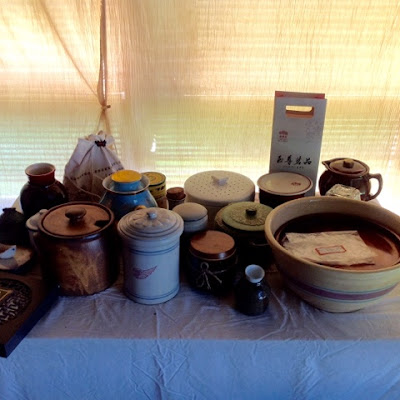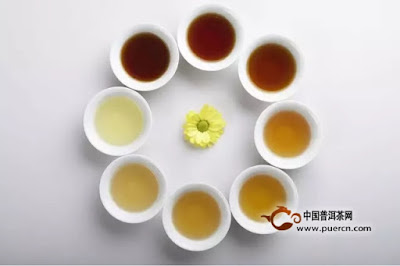 |
All stored food is alive, except for things like dried peas or true
canning. Even these have a shelf life, a time when they taste best. But
fermenting foods like puerh tea are indeed truly alive, and the organisms
within are living creatures. We can’t see those living creatures without the
aid of a microscope, but they are very much alive.
Puerh is a living food, we cannot store and ignore.
Anxiety around puerh storage is largely justified if a
person wants to store it and ignore it. Some people do this, but you are playing
a crap shoot. You can put several bushels of potatoes or apples in your
basement for a month or two. When you go back to check on them, you are likely
to find some spoiled or moldy apples and potatoes which you need to remove.
Perhaps you can identify the reasons behind why a particular apple spoils,
maybe it had a bruise, or maybe you can’t figure out what happened. But you
know that even potatoes from the same harvest will have a few that go bad for
no particular reason.
Maybe you like to make wine. You store a dozen bottles,
and two turn to vinegar, one explodes and the other nine are drinkable. You may
learn something about the bottles that went bad, but to some extent you also
accept loss as part of the hobby. We are still trying to fully understand why
some wines and whiskies turn out better than others. The same is true of puerh tea, we are only learning why some cakes turn out better than others.
If you enjoy flowers, you might decide to start a garden of
sorts. Orchids and roses are beautiful, but are like babies requiring daily
care. Do you want to spend the time? If you find caring for your orchids
relaxing and engaging, then these flowers will bloom under your mothering. One
cannot ignore orchids, and knowing this you might wisely decide to plant day
lilies instead which need little or no care and are beautiful in their own
right.
Do you want to spend the time with storage?
I prefer cats to dogs. I love dogs, but I believe that dogs
need to run, or at minimum vigorously walked more than once a day. Do I want to
spend the time walking the dog? If I have a large property where the dog can
run, maybe it can go without me. But then I’ll still need to check it for ticks
and burrs or other wounds. And like it as not, that dog will still prefer to
sleep in my bed than outside, so I’ll need to pay a great deal of attention to
this dog. I don’t have much interest in doing what really should be done for a
dog and I cannot bear it when I see dogs neglected. So I have cats. My cats are
still a lot of work, but I enjoy doing what they need.
 |
Can I do what it takes to maintain a large collection?
Puerh shopping is fun, and most of us know how easy it is to
click and buy and watch the tea pile up. But do you have a storage solution for
your tea? How much tea do you drink every day? Can you consume most of your
collection within a few years? If not, then you need to find a way to store the
tea so it continues to mature.
If I don’t enjoy puerh storage, then perhaps I need to keep
my collection small to a series of drinkers that I will consume within a few
years. Or maybe I should spend my money on truly fine aged puerh teas. I could
buy one of the 1990s Liming for $1300 and focus my attention on drinking this
one fine tea, rather than spend the same amount of money on brand new puerh
teas only to lose them to fading and drying. Ah, the idealism and purity of
this! For all our aspirations to stop with one cake, not many of us manage to
avoid the slippery slope of buying more.
You hereby invited to the hobby of puerh storage.
Sheng puerh ferments in ideal conditions of at least 70-85
degrees F, or about 20-30C with relative humidity of 65-75%. When temperatures
are a little lower, the microbial activity slows accordingly. When humidity is
lower, then the tea begins to get dry. To maintain and preserve your tea “as
is,” you will need room temperature and 50-60% humidity as minimum parameters. Lower
than these numbers and the tea begins to dry, and the microbial activity will
slow. If your numbers are higher, then you must provide air circulation for the
tea, and babysit for mold.
Regardless of how or where you store your tea, checking the
tea is important if you want to maintain fermentation conditions. You won’t
lose your entire collection overnight. You’ll get warning signs. Too cold and
dry, your tea will lack odor, it will not have any tea smell. Too hot and wet
and you’ll see signs of mold, well before your entire collection is affected.
Your tea will pick up any odors from its surroundings, so
choose its company carefully. I found my tea picked up cardboard box odors. Kitchen
storage is a bad idea because of cooking odors. Wood too can impart odors if
the wood is fragrant, or contains oils as cedar wood does.
If your climate is dry, then porous containers like clay
jars will be far too drying. If your climate is hot and humid, on the other
hand, then clay jars might be a fine idea. But you still need to check the tea!
Bugs and rodents like tea as much as you do, and can get into your collection
unless you watch out.
When choosing storage, check with people who have the same
climate as you have. Don’t blindly copy storage conditions in Asia unless your
climate is the same as Asia. Feel free to experiment! Check out traditional
storage methods where you live. In my part of the world, people traditionally
used glazed thick clay crocks for vegetable fermentation and food storage. I
found these local crocks are ideal for storing puerh tea, but I still need to
add humidity much of the year. In summer, however, my tea can enjoy the local
hot and humid climate.
 |
| My blog has a number of ongoing articles on crock storage as an option |
Store puerh tea with love.
Check your tea because you love it! Check it not in a panic nor
worry about losing your collection. You know what? There is always more tea. Tea
will be your friend for many years. You can baby your most precious cakes, and
with others you can always start over. Sniffing the tea and brewing up a bit is
the pleasure we have, like gardeners who taste their bounty in a salad. When I
get home from a long day, or am feeling my body’s aging and fatigue, I get a
lift from heading to my crocks and checking a well-loved cake of puerh tea.
Puerh tea
Enjoyment
Love
Microbes
Happy Molds
Tea Friends
Health
Long Life
Requiescat in Pace


Thank you for sharing your knowledge on the subject. I totally agree on how checking your aging tea can become a little pleasure. I live in a tropical area of South America, it is rain season and I do notice how my shous seem to have come more alive in the past few weeks, on the other hand my shengs don't seem to be overly fond of the "tropical winter".
ReplyDeleteI wonder what your thoughts are on how best to measure relative humidity (rh). Combined temp/rh meters can be bought cheaply, but how accurate and reliable atre they? I think the room my stash is kept in is maintained at fairly stable temp and rh levels year round, but I am guessing and perhaps should find out, given that it contains the all tea i need to see me out, and perhaps quite a bit more!
ReplyDeleteWell I used to measure with a device somebody gave me from the Weather Channel. It syncs with the satellite and is supposed to infrared with an outdoor device that I couldn't get to work for some reason. After using it about six months I kinda missed it hanging on the wall because it changes time with Daylight Savings without me needing to do anything.
DeleteSo now I use a vintage Bakelite hygrometer from the 1940s that gets stuck at 45% and won't go higher. Otherwise I just use my body which has two humidity settings, the Painful and the Miserable. Miserable is anything over 50% RH, Painful is over 60% and my tea is therefore good.
One of my favorite things to do after a long day at work is sit down on the floor in front of my pu cabinet, and take out jars to sniff cakes, samples, whatever I have, pulling tea out from the back, opening a large crock and rearranging the cakes and putting it back, or a small one with a single tea in it to take a sniff, all the while thinking about what I want to drink that night: young, middle aged, aged, shou, sheng, dry stored, wet, simple or complex. This is my happy place.
ReplyDeleteI forgot to mention that funny enough, it rarely ever occurs to me to worry about any of it.
ReplyDeleteGood! Stop the thought right there...
DeleteAhhhh ...... The good old appliance of science eh?! I think I will 'invest' in one of the cheap digital jobs sold on line, and hope it is a bit more reliable than the piece of seaweed tacked to the cupboard door :-)
ReplyDeleteThey're not that bad. I have a cheap one on top of my jars, and reacts well to changes in humidity. It's usually around 50% where I live, so I leave my laundry to dry near the jars, then it goes up to max 65%. (just be careful to use odorless detergents).
DeleteWorked well until now, the tea is a bit on the dry side, but the smell in the jars makes me want to take a bite from the cakes.